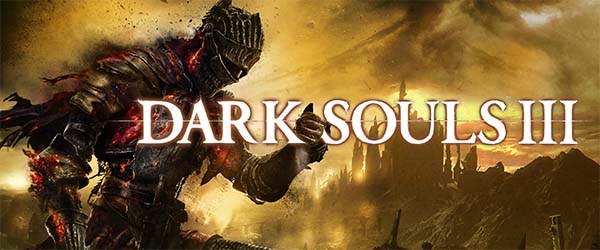
PC elitists now have yet another bragging point. Considering that Bloodborne ran smoothly at 30 frames per second on the PS4 (from my experience), and that Dark Souls III was supposedly built upon that same engine, I expected that the PS4 version would perform on par with (or maybe even better than) the PC version. I was wrong. Both console versions of Dark Souls III are capped at 30 fps, but their actual performance doesn't even meet that standard. This is a big problem considering that the game plays almost as fast as Bloodborne. Dropping a few crucial frames of enemy attack wind-ups can mean the difference between a successful dodge or parry, or losing a third of your health to a single attack. Bloodborne had the load screen issue that was that game's near-debilitating "known shippable"; and now Dark Souls III has its console framerate as being the major launch issue that must be fixed. At least Bloodborne's problem didn't impact actual gameplay...
Table of Content
A challenge to Souls fans
This is probably the hardest game in the lineup. In fact, it may even be too hard in some ways. Enemies are very aggressive and relentless, they are very fast and swift at attacking, and they are very good at tracking your movement during an attack. I feel like the game is sadly front-loaded with excessive difficulty. Oh, don't get me wrong! It's hard throughout, and there's still some definite mid-and-late-game peaks of difficulty. But this game easily has the highest barrier to entry of any game in the lineup.
Dark Souls III is very hard and very much front-loaded with difficulty.
It's one thing to provide a challenge, but the early levels of this game maybe cross the line into outright cruelty. If I weren't already invested in the series, I might not have even made it past the Lothric knights in the High Wall. Yeah sure, Demon's Souls had the Red Eye Knights, and Dark Souls had the Black Knights, and Bloodborne had the warewolves; but in those cases, those difficult enemies were blocking optional paths and items. This is why I can kind of tolerate the mutating tentacle monster on the rooftop that hits very hard, has a ton of HP, obscures half the screen, and causes an annoying framerate drop. Yeah, it's located in a critical path of the level, but it can be easily avoided and is basically just guarding a crystal lizard. The difficult Lothric knights, on the other hand, are placed in critical bottlenecks that must be passed as part of the necessary path of progression through the level, and they will shred new players to pieces! Heck, even that fat, winged knight going around in circles in the courtyard is easier than the Lothric Knights.
And then you get to the Undead Settlement, which is a maze full of ambushes and difficult enemies. Those fat evangelists and the large cleaver undead hit hard and have deceptively long reach and multi-hit combos. This is at a time when your HP and stamina are so low that you can't reliably block their attacks. Their long reach and relentless aggression means you can't back away either. So you're stuck having to stick to close range and roll through their attacks - a maneuver that can result in a quick death if you make but a single slip-up. I had a lot of trouble handling these enemies (as I was still getting used to the new timings for dodging and parrying, and the stamina requirements for blocking), and so I imagine that many rookies will likely be completely overwhelmed.
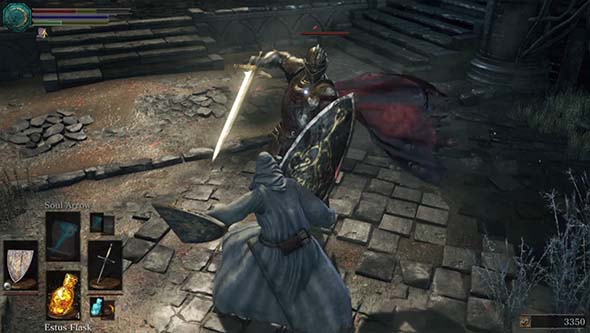
Dangerous enemies have narrow windows for parrying their attacks, making it hard to practice this technique.
There's a higher skill floor than in previous titles, and the game demands a further degree of mastery of rolling, stamina management, i-frames, and weapon movesets that previous games simply didn't require. Bloodborne also toes with this line, but Dark Souls III seems to go a bit further. The problem here is that enemies become far too fast and deadly far too early in the game, and the player character remains slow and relatively weak. What's worse is that the game breaks with the original's insistence on fair difficulty by apparently completely failing to enforce the rules regarding stamina for enemies! This was also a problem in Dark Souls II, but it didn't bother me quite as much because those enemies had slower attacks that were generally easier to dodge.
There's no gradual ramping up of challenge for the player to learn things like roll and parry timings, and there aren't any large, slow enemies to practice these techniques against. Bloodborne had very fast enemies to go with its very fast combat, but the character was also equally fast. Bloodborne also had the Brick Trolls, whose telegraphed attacks gave plenty of opportunity to practice parrying in the very first level while still making progress. Dark Souls III simply doesn't have this. There's the undead spearmen that are easy to parry, but they're so slow and defensive that you'll likely just get bored waiting for them to attack and miss your opportunity to parry. Sure you could go back to the tutorial level to practice parrying, but then you're not making any progress. There's also a lot more instances early of mobs, including the presence of difficult casters (or even bosses) being among those mobs. Fortunately, the boss is very slow and lumbering, and the casters have good audio cues for when they're casting that help to make these mobs less frustrating to deal with.
The big, armored elephant in the room
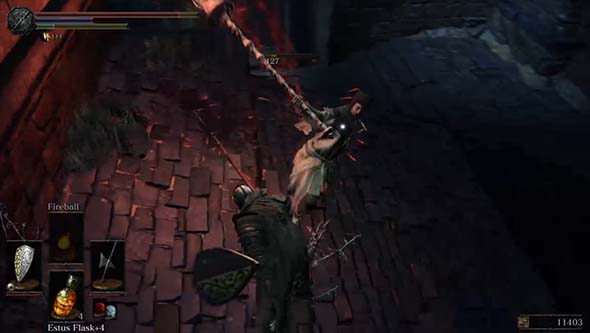
Poise has been disabled for players, which means enemies will always stagger you, but you might not stagger them.
Perhaps the biggest contributor to the game's difficulty early on is the completely baffling way in which poise and defense work - which is that they don't. In addition to not being able to upgrade armor to improve its defenses, the poise stat appears to have been completely disabled for all players in the game's code for ... some reason. Poise was one of the best additions from Dark Souls 1, and its apparent removal completely baffles me. Is it bugged and they're planning on fixing and enabling it later via a patch? Is it planned to be part of DLC? "Hey, want poise back? Pay $15 for this DLC!" The value still shows up in the UI, and there's still rings and weapons that exclusively improve poise, so it definitely seems like FROM intends for poise to be in the game. The enemies seem to still have poise, so this situation seems completely unfair. This might be part of the reason why the start of the game feels so difficult, since those damned speedy Lothric Knights can hit through your attacks, but you can't hit through theirs! [More]
fad05dd1-7cd5-454e-9102-9178f6fa617e|5|3.6
Tags:Dark Souls, Dark Souls III, From Software, Namco/Bandai, PlayStation 4, PSN, XBox One, XBox Live, PC, Steam, online, multiplayer, co-op, PvP, invasion, phantom, covenant, Lord of Cinder, Firelink Shrine, Demon's Souls, Nexus
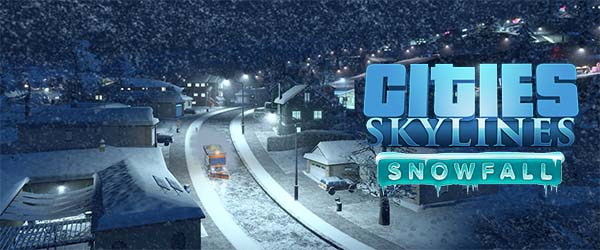
I described Cities: Skylines' first expansion, After Dark, as " just tak[ing] the Cities: Skylines canvas, and offer[ing] the player a few more colors to optionally paint with." That expansion didn't really do much to change the way that the game is really played, but rather just focused on adding further specialization options for any city that you care to build. I wasn't too upset because the core game is still a phenomenal foundation to build upon, and the expansion just gave us more to play with within that same phenomenal foundation. Snowfall, however, is even more narrow in scope. It offers one new color to paint with, and that color is white.
I got really excited when I loaded up Steam and saw the title of the new expansion. I had written a wishlist blog in which I specifically asked for the next expansion to offer seasonal weather changes and more recreational and transportation specializations suited to those different seasons. On the surface, Snowfall seemed to provide that. There's now a winter, and snow, and you can build a specialized winter wonderland. But that's the extent of what this expansion provides, and that's disappointing.
Snowfall doesn't provide a full season system or any real changes to the game's core economic loop. Instead, it has a few snowy, winter-themed maps in which you can build snow-themed cities. Those winter maps are always snowy, and the non-winter maps are never snowy (although they can see occasional rain and fog). Note: I'm going to get real tired of saying "non-winter maps", so henceforth, for the sake of simplicity, I will refer to them as "summer maps", even though summer isn't really a thing (yet). Your city doesn't progress from springing to summer to autumn to winter (or even just from summer to winter) and then back again, and you don't have to manage your economy so as to maximize profits during your tourist season and find a way to maintain employment and revenue during the off season. Depending on which map you select, it's either always winter, or it's always summer.
I complained about After Dark feeling like I had to go out of my way in order to use the expansions new features and specializations, but at least those features and specializations were available in all cities, and they could be applied to my existing cities from before the expansion. You have to go so far out of your way to use the Snowfall features that you have to start a whole new game on a specific subset of maps. It makes After Dark look like a broad game-changing expansion by comparison.
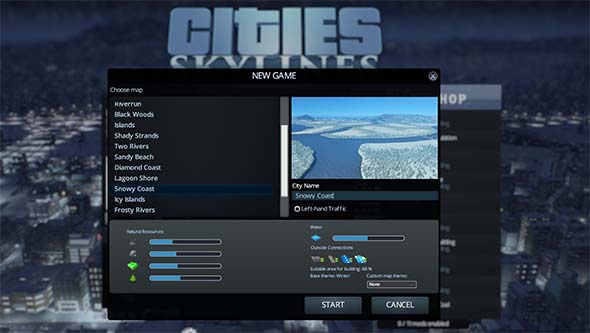
Only maps designated as "winter" maps will have snowfall, and they aren't very different from existing maps.
Disconnected from reality
The actual functionality of some of these winter buildings is also questionable. One of the first snow buildings that you'll unlock is the "snow dump", which is a landfill for snow. Snow plows in this game will drive around the city similar to garbage trucks, actually collecting the snow off the streets, and then taking them back to the snow dump building, which (according to its description) melts down the snow to make room for more snow. It seems like they just took the garbage truck functionality and copy-pasted it to apply to snow, only without the need for a separate incinerator building.
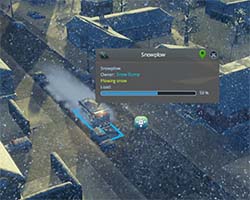
Snow can slow traffic and must be plowed.
The really weird thing is that there is also a new general road maintenance office that keeps the roads in good repair and traffic flowing smoothly. If you don't bother to build the road maintenance office, or build the snow dump or plow the snow, it will slow down your roads and eventually make them unusable. Why did these need to be two buildings? Why couldn't the road maintenance office also be the depot for snow plows?
And then there's the ski buildings, which also don't seem to work in any way comparable to real life. The ski resort is an artificial ramp that you build on flat ground. Again, that's not really how ski resorts work. Typically, a ski resort would be built high up on a mountain, where there's a natural slope and a lot of snow. The game does include a separate ski lodge building, which you could build up in a mountain, but it wouldn't work all that well. It seems to me that the Ski Resort shouldn't be a ramp, it should just be the ski lift that you build on inclined terrain, and the Ski Lodge should be built nearby and should enhance the functionality of the resort. In fact, the new snow maps don't even include mountainous terrain on which to build a more realistic ski resort and lodge. So this all seems to be a result of the game's underlying framework not having very good support for building on slopes, and Colossal Order didn't bother to design a system to allow such niche buildings like a ski resort to be built on a slope.
I may live in a desert, but I'm pretty sure that this isn't how snow plowing or ski resorts are supposed to work...
Look, I live in the desert of Las Vegas, where it was 80 degrees by mid-February, and air conditioning is not an "option" for a car. Maybe it's not my place to tell a development team in Finland how ski resorts and snow plowing are supposed to work, but I'm pretty sure that this isn't how ski resorts and snow plows work!
Don't get me wrong, these buildings are all functional, and they all work within the game's existing mechanic set. It isn't like they are broken; they're just not very realistic, and they have a disappointing feeling of sameness to them, since they don't feel functionally distinct from buildings and features that already exist. For games like this, I tend to lean towards wanting more realism whenever possible, but that's a subjective personal preference. I understand that this is just a game, and certain amounts of abstraction and creative license need to be taken... [More]
1d6478f3-d83d-487b-a545-922d69eb8b1b|6|4.2
Tags:Cities: Skylines, Cities: Skylines: Snowfall, expansion, Paradox Interactive, Colossal Order Ltd., PC, Steam, Steam Workshop, city simulation, weather, snow, rain, fog, skiing, snowboarding, sky resort, ski lodge, heating, geothermal, cold, temperature

I'm starting to feel like quite the prognosticator. Earlier this year, I started tossing around the idea of Nomadic civilizations for future Civ games. Around the same time, Creative Assembly announced Attila: Total War. They had apparently come up with almost the same idea independently at the same time. Well, now the teams at Firaxis have also implemented a variation of my idea for their new expansion to Beyond Earth, called Rising Tide.
This expansion seeks to remedy several of the core complaints with the Beyond Earth game. In my original review for Beyond Earth, my two biggest complaints were that the game and its leaders lacked the personality and variety of Civilization V, and that it just didn't feel futuristic enough. Both of these complaints ended up being the major focus of the first expansion, which definitely helps to make Beyond Earth stand out a little bit from its more realistic counterpart.
So we sailed up to the sun, till we found a sea of green
One of Beyond Earth's biggest failings was its lack of creativity in using its futuristic setting to innovate gameplay. The game felt very much like a reskin of Civ V rather than a new game. A big part of this was that the map posed many of the same sorts of restrictions on players that the Civ V map did: mountains, canyons, and oceans were all obstacles either impassable by units or uncolonizable by cities.
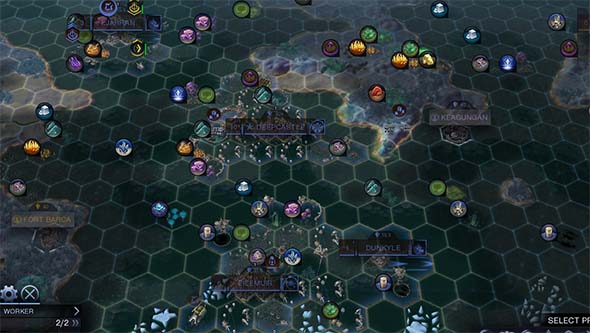
Aquatic cities and civilizations help to separate Beyond Earth's futuristic setting from Civilization's historical roots.
Well now one of those restrictions has been lifted, and civilizations can build floating cities in the oceans. Such cities can even be moved in order to claim new tiles or to act as mobile military bases. This opens up some interesting (and sometimes silly) new strategic possibilities, but the whole mechanic feels a bit contrived to me. Moveable cities is something that I think can work very well in Civilization, but I just don't feel that Firaxis gave us much reason to ever need to move cities in this game. My proposal for nomadic civilizations was two fold: such a faction could mobilize its entire civilization right up to an enemy's borders during war; and it could also move in response to changing map conditions (migrating animal resources or climate change) during peace. Beyond Earth hits that first point by turning cities into massive aircraft carriers, but there aren't any mechanics in place to make the map a factor.
Fish and other harvestable sea creatures don't migrate, and other resources don't move. So if you aren't using your aquatic cities as mobile military bases, then there's never any real need to move them. And if you're not playing as the North Sea Alliance faction, then the cost to move a city can feel prohibitively expensive. The people at Firaxis seemed to have recognized this, and so they made it so that aquatic cities don't grow their borders based on culture. Instead, you must either buy new tiles or move the city itself in order to acquire adjacent tiles. But since moving takes valuable production time away from the city, I rarely find myself moving a city, and instead I just buy any tiles that I want.
Aquatic cities can be moved, and can act as mobile military platforms and aircraft carriers.
There are other pros and cons to aquatic cities, such as health benefits, faster virtue acquisition, and more profitable trade routes. You can also move the cities around to temporarily acquire resources that allow you to build specific resource buildings, but at the cost of possibly temporarily hurting your city's growth or production (and maybe even starving the city if you move away from food-generating tiles). So there's a lot to think about when build an aquatic or nomadic civilization, but it all feels kind of like ad hoc mechanics in order to make the mechanic seem more meaningful than it actually is. That isn't to say that mobile cities is a bad feature in Beyond Earth. It's perfectly functional, and can be fun to play around with. It just feels a little gimmicky.
Just look at the world around you, right here on the ocean floor
It certainly helps that the oceans themselves are a much bigger part of the game. The ocean isn't just divided into coastal tiles and empty ocean anymore. There's a whole host of new aquatic resources, and even the sea floor itself has different features. This definitely provides some incentive and reward to building floating cities, since the ocean can be a rich source of resources. The ocean tiles themselves can even be improved with a variety of new improvements (including basic farms and mines).
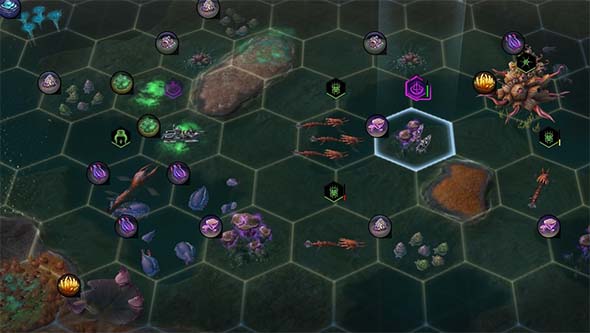
The oceans are alive with life and resources, giving reason to found aquatic cities.
Aliens are also active in the oceans. Sea creatures will build nests (just like their land counterparts), and there's a new alien creature called Hydrocoral that is stationary but which spreads across the ocean surface if left unchecked. Resource pods, artifacts, and quest triggers can all also be found in the ocean. So there's plenty to do in the water now, oceans feel more like a genuine part of the map rather than just dead space between continents, and the variety of features and resources in the ocean helps to make the world look more alien.
... [More]
da86c697-6def-4ade-b575-051869e1f38d|2|5.0
Tags:Sid Meier's Civilization, Civilization: Beyond Earth, Civilization: Beyond Earth: Rising Tide, Rising Tide, Firaxis, 2K Games, PC, Steam, strategy, grand strategy, turn-based strategy, science fiction, space, water, aquatic city, nomad, ocean, trench, submarine, diplomacy, affinity, alien, Civilization: Beyond Earth
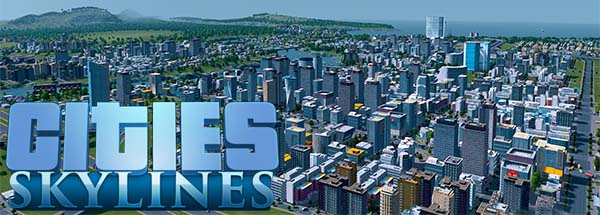
I've been playing the somewhat-underwhelming After Dark expansion for Cities: Skylines. I love Skylines, but there are a lot of elements of the game that I wish would change, and a few things that I would like to see added. I hope (and expect) that Colossal Order will continue to support the game for many years to come with new DLC and expansions, and this blog will outline some of the features, mechanics, and items that I would like to see changed or added to the game.
It should go without saying that, since this is a PC game (with a built-in asset creator), many (if not all) of the following suggestions might already be implemented in one or more mods. I haven't played much with mods in this game yet, so I don't know what might be available. In any case, there's no reason why ideas already implemented in mods can't also be turned into formal game systems by the developers.
Table of Contents
The one thing I miss from SimCity (2013): Modular buildings
As much as I love Cities: Skylines, and as much as I think it blows the SimCity reboot out of the water, there is one mechanic of SimCity that I absolutely love, and that occasionally makes me want to go back to SimCity: building upgrades. It's a bit ironic that SimCity, with its ridiculously limited city size, is the game that allows you to add additional components to existing buildings that makes them take up more physical space; yet, Skylines, with its expandable city plots, uses only prefab buildings of set sizes. So the game that puts a premium on real estate availability encourages you to leave empty space around certain buildings. I guess it makes sense. SimCity's limited size means you can't afford to build whole new buildings and must make due with what you have. Skylines allows you much more space to just keep copy-pasting the same schools and garbage dumps every few blocks.
Having to build new schools every four or five blocks can become tedious in Skylines, especially when the city starts to cross into being a metropolis. I like that the game requires that you build more infrastructure in order to keep up with population growth, but I wish that you could push the existing buildings a bit further before having to build whole new ones... [More]
0d10b666-b01c-4a5a-b3bd-c0c7af4faf36|4|5.0
Tags:Cities: Skylines, Cities: Skylines: After Dark, Paradox Interactive, Colossal Order Ltd., PC, SimCity, city simulation, day, night, seasons, climate, tourism, leisure, beach, government, parking, cul de sac, solar
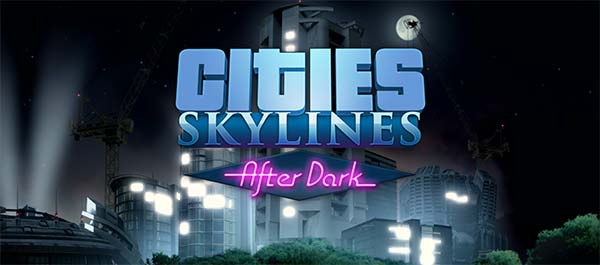
It's been a very long time since I've had a city-building game that I really enjoy. So it was a real treat to find Cities: Skylines last year. It was the first game to really capture the magic of the classic SimCity games and make them work in full 3-D, and managed to achieve the goal of abstract population agency that the SimCity reboot failed so horribly at. But as much as I loved Skylines, I was also very aware of many of its limitations. It didn't have as much content as you might expect from a game coming from a larger publisher (like EA), and there were certain elements of its abstraction that felt a little shallow or weird. The game's first expansion, After Dark, tries to address these limitations, but it doesn't really succeed.
The free update is a nice gesture, but ...
First and foremost, I have to clarify exactly what the expansion encompasses, since Colossal Order has created a bit of confusion on this topic. They launched a free update for the base Cities: Skylines game in parallel with the release of the After Dark expansion. This update included some of the core feature upgrades that the expansion's content depended on. Most notably, a day/night cycle, new zoned buildings, and upgraded crime systems. If you have Cities: Skylines, then you get these features as a free patch, and have probably been playing with them for months.
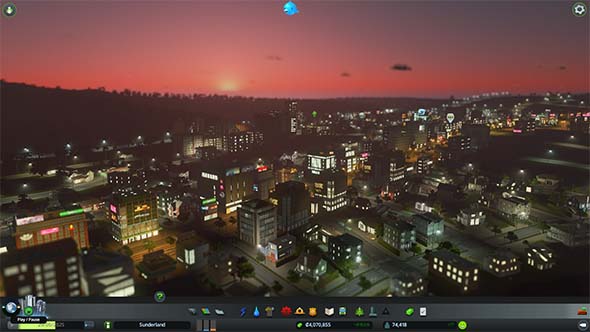
The day/night cycle is a free upgrade to the core game, but makes the core game feel somewhat incomplete.
While I applaud Colossal Order for the good will they foster by being willing to give away new functionality for free, this does kind of put players of the vanilla game in a strange situation. You get some of the new features, but not any of the ploppable buildings or city policy options that make them work. You get more crime, but not the prisons in which to lock up and rehabilitate criminals. You get the day/night cycle, but not the fancy new leisure and tourism zones that make nighttime mechanically relevant. In some ways, it takes the core game that felt very complete on its own, and suddenly makes it feel incomplete in subtle ways.
Fortunately, the menu gives you the option to turn the day/night cycle off, which helps to preserve the integrity of the original game. But then you don't get the new feature.
The update won't harm any of your existing save files though - with one major exception. If you made the unfortunate mistake of creating a city that was completely dependent on solar power, then the day/night cycle will screw that city over big time! In the core game, this was actually the most optimal way to go. Solar didn't pollute, wasn't dependent on depleting resources, and money was easy enough to make that the cost wasn't a big enough deterrent to using solar. But with the day/night update, once the sun goes down, all those fancy, expensive solar panels completely stop working! This can lead to your entire city going into a blackout as soon as you boot up your save file. Suddenly, not only is solar non-optimal, but it's practically useless since it doesn't work for half the game. And this isn't something that you can fix by just increasing solar power funding or building more plants; the power output drops to zero!
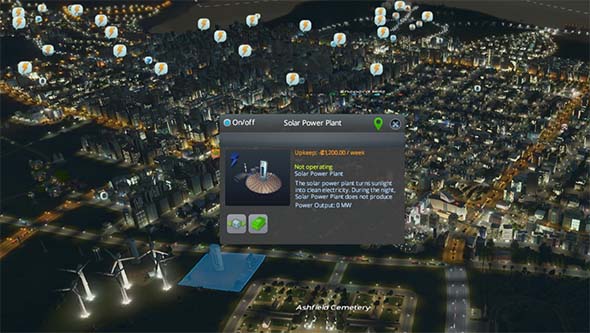
Solar power plants stop working completely during the night, leading to massive blackouts.
Fun at night, and in the sun
I did complain somewhat about the lack of a day-night cycle in the base game, but the implementation that Colossal Order gave us is a bit uncomfortable and awkward. The rapid progress of a "day" in the game means that they couldn't transition from day to night in a single game-day, or else the game would just be constantly flickering between day and night. The developers apparently didn't want to slow down the game-day either, since that would probably upset many elements of the game's economic and agent systems. So instead, your cities get about a month-and-a-half of day, followed by about a month-and-a-half of night. Individual citizens seem to go about a daily cycle within this time. They aren't bound to it though. I've seen some citizens go back and forth between home and a near-by job several times during the day-time, then spend the whole night out at a restaurant or nightclub; and other citizens can spend the entire daytime commuting to and from work only to spend most of the night sitting in the office. They start their cycles at staggered times during the day; thus, sparing us from the annoying pathfinding and gridlock issues that plagued SimCity (2013). It all ... works ... at a very abstract level; it just feels weird... [More]
f5d3fc25-4e52-471a-a9cb-17667d979a88|2|3.5
Tags:Cities: Skylines, Cities: Skylines: After Dark, Paradox Interactive, Colossal Order Ltd., PC, expansion, Steam, Steam Workshop, city simulation, day, night, tourism, leisure, beach, hotel, nightclub
|

| 12 | | | | | | | 60 | | 11 | | | | | | | 55 | | 10 | | | | | | | 50 | | 09 | | | | | | | 45 | | 08 | | | | | | | 40 | | 07 | | | | | | | 35 | | 06 | | | | | | | 30 | | 05 | | | | | | | 25 | | 04 | | | | | | | 20 | | 03 | | | | | | | 15 | | 02 | | | | | | | 10 | | 01 | | | | | | | 05 |
|